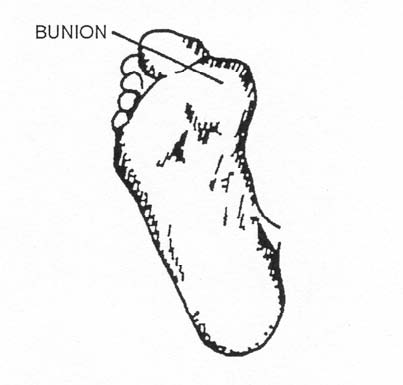The Musculoskeletal System
Lesson 2: Diseases and Disorders of the Feet
Section IV: Arthritis of the Feet
2-25
2-25. HALLUX VALGUS
Hallux valqus is the name for a severe condition that begins with a bunion. The word "hallux" is another name for the big toe (the first digit of the foot), and "valgus" means bent outward and twisted. In the condition hallux valgus, the big toe bends outward (either over or under the other toes). The large bunion becomes even larger.
a. Cause of a Bunion. A bunion, a painful foot problem, is an enlargement of the head of the first metatarsal bone (the big toe). See figure 2-13. Signs of a bunion include inflammation, swelling, and protrusion of the base of the big toe. Often the pressure of shoes causes the metatarsophalangeal joint to form a bursa (bunion). A common theory is that high-heeled, narrow-toed shoes were and are responsible for many bunions.
b. Description of a Bunion. The bunion enlargement is actually a form of arthritis that indicates that the cartilage and bone under the bump are degenerating. (The cartilage is turning yellow and is pick-marked.) The turning of the toe and the accompanying bump may cause a person to have an extremely wide foot. Additionally, the arch of the foot may sag because of the way the big toe is pulling the entire foot out of shape.
c. Signs/Symptoms. Included are the following:
(1) Bony growth at the joint (exostosis).
(2) Inflammation and infection of the toe.
(3) Inflammation of the periosteum (periostosis).
Figure 2-13. Hallux valgus (bunion).
d. Treatment. Follow this treatment:
(1) Eliminate the pressure on the affected foot.
(2) Surgery may be indicated for adolescents or those for whom bunions are persistent problems.
(3) Avoid high-heeled, narrow-toed shoes.


